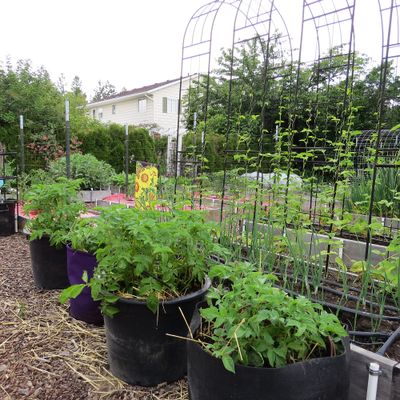In the Garden: Potatoes are a beautiful and bountiful addition to the garden

Potatoes are one of my favorite veggies to grow. The plants are beautiful in the garden and produce a large harvest in a small amount of space.
You can plant potatoes once the soil temperature has reached 50 degrees. Start with certified disease-free seed potatoes from a garden center or online source. If they’re hard to come by this year, use organic potatoes from the grocery store.
We set aside several potatoes from last year’s harvest primarily because one of our favorite varieties (Blue Belle) is no longer available in the U.S.
This year, I’m chitting my potatoes for the first time. I first heard this term while watching the BBC’s “Gardener’s World” program. It means pre-sprouting seed potatoes so they’ll get off to a good start.
This involves exposing your seed potatoes to light – inside your home, under grow lights or outdoors – two to four weeks before planting them. Once the potatoes have inch-long sprouts, they’re ready to be planted.
Many gardeners cut up their seed potatoes into large chunks that contain at least two “eyes” (where the sprouts emerge) and then let the cut surfaces dry out for a day or two prior to planting; this reduces the chance of rotting. I prefer to use small seed potatoes instead and plant them whole.
Place each chunk or whole potato 4 inches deep in your garden bed and space them about 12 inches apart. You can also plant potatoes in cloth grow bags or large containers. That’s what we did last year. The plants grew beautifully and were very productive. It was a great way to expand the footprint of our garden without having to build more raised beds. There’s never enough space for everything we gardeners want to grow, right?
Let the plants put on about 6 inches of growth, then add more soil around them, about an inch below the top leaves. This is called “hilling.” Repeat this step again after another 6 inches of new growth. It encourages the plants to develop more tubers along the stems.
At this point, place a thick mulch on the soil surface. I recommend using shredded leaves, compost or grass clippings from a lawn that hasn’t been treated with herbicides. The purpose of the mulch is threefold: it impedes weed growth, helps the soil retain moisture and prevents sunlight from hitting any potatoes developing at the soil surface.
When exposed to direct sunlight while growing, they manufacture a toxic compound called solanine, which turns the potatoes green and is harmful to eat.
Colorado potato beetles can be an annoying pest. The adult beetles are ½-inch long and have black and yellow stripes. While they do a fair amount of chewing on the foliage, their reddish-orange larvae are even more destructive.
The easiest way to deal with them is by hand-picking the beetles and larvae off the plants. Be sure to look for the beetles’ orange eggs on the undersides of the leaves and crush them. The good news is these pests have a lot of natural predators.
Once the plants start blooming, you can sneak a few new potatoes for a meal, but wait until the plants get completely frosted in the fall before harvesting the rest.
We store our tubers in bins filled with lightly moistened straw in our garage during the fall and winter. This works really well and keeps the potatoes fresh and firm.
Susan Mulvihill is author of “The Vegetable Garden Pest Handbook.” She can be reached at susan@susansinthegarden.com. Watch this week’s “Everyone Can Grow a Garden” video at youtube.com/susansinthegarden.